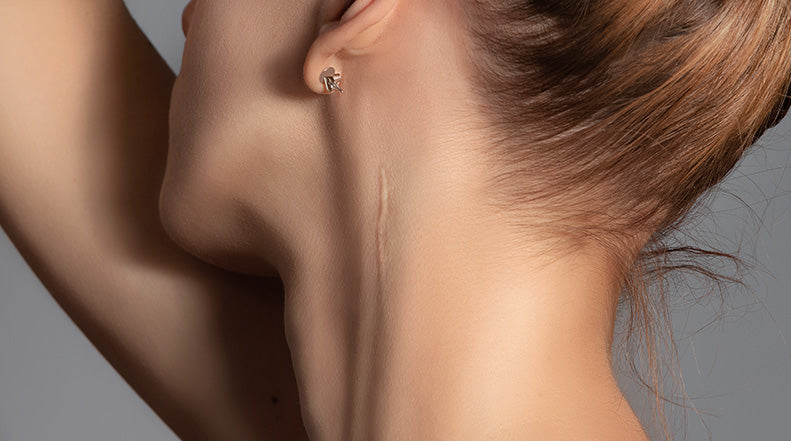How to Get Rid of Hyperpigmented Scars

Hyperpigmented scars occur when an area of the skin becomes darker than the skin surrounding it. This discoloration is caused by the overproduction of melanin. Melanin is a broad term for a group of natural pigments responsible for our skin tone. The darker the skin tone, the more melanin in the skin. Hyperpigmentation can affect both small and larger areas of the body, and resemble anything from a freckle to a large birthmark. These can occur in all different areas, and in severe cases, they can cover most of the body. There are many different causes of hyperpigmentation, from diseases and disorders to simple life choices. If you know what is causing the hyperpigmentation, it makes it easier to determine the best method of treatment. In most cases, hyperpigmentation is not dangerous — but it can be a symptom from other, more serious disorders. Any newly hyperpigmented marks or spots should be discussed with your doctor or dermatologist in order to rule out anything serious, such as melanoma. It is possible to treat and repair damage caused by most types of hyperpigmentation.
CAUSES OF HYPERPIGMENTATION
One of the most common forms of hyperpigmentation are often referred to as ‘sun spots’. These are small to medium spots on the skin, usually on the hands, face, or decolletage, that are caused by sun damage to the skin cells. The change in color occurs when sun exposure creates an increase in melanin production. Melanin is the name of a group of natural pigments found in most organisms. The amount of melanin in each person varies according to genetics and skin type.
Another common reason for hyperpigmentation is something called melasma. Melasma is a specific type of hyperpigmentation that most commonly arises during pregnancy, and is due to hormonal changes. Other disorders that affect the hormones, such as Addison’s disease, can also cause a change in melanin production. Certain medications can cause hyperpigmentation as a side effect and freckles are considered a form of hyperpigmentation. Injury to the skin and high levels of stress can also cause hyperpigmentation.
Other causes can include:
-Not wearing sunscreen of at least SPF 15 daily (even in the winter months) to protect against ultraviolet rays
-Using skincare treatments that are too aggressive, as these treatments make the skin more susceptible to sun damage
-Improper wound care
-Smoking cigarettes
-Cancer
HOW CAN HYPERPIGMENTATION BE TREATED?
Treating hyperpigmentation needs to be done in steps. For example, if the hyperpigmentation is caused by Addison’s disease or pregnancy, you should speak to your health care professional about ways to control your hormones and anything else that might be contributing to the spike in your melanin levels. Once the cause is determined, you can treat the dark spots with whatever skin lightening cream your doctor suggests. Be sure to choose a cream with no harmful ingredients like bleach. Licorice root extract and vitamin C are two powerful nutrients that not only expedite the lightening process, but nourish and rejuvenate the skin.
In combination with the use of a lightening serum, try relaxation exercises to help balance stress levels in the body. Quit smoking, and if need be, speak to your doctor about hormone balancing methods.
A great option for scar treatment that also protects against UV rays and can help prevent scars from becoming hyperpigmented in the first place, is NewGel+UV. This product is light and blends into the skin in order to cover, protect and lighten hyperpigmented scars. This gel is wonderful for facial hyperpigmentation, because it dries clear and allows for facial mobility instead of leaving your face stiff and mask-like. In this way, it lets you participate in your daily routine without fuss or hindrance.
More invasive treatments include chemical peels, microdermabrasion, and use of strong skin creams that contain either hydroquinone, alpha hydroxy acids or glucocorticoids. A bit about each treatment method:
Chemical peels: chemical peels can improve the appearance of hyperpigmentation issues, especially sun spots, age spots and acne scarring. This procedure uses a mixture of acids to exfoliate the uppermost layers of the skin. It can be performed on the face, neck, chest and hands.
Microdermabrasion is a non-chemical, non-ablative procedure that does not destroy skin tissue and therefore doesn’t require significant recovery time.
Hydroquinone based skin creams are skin bleaching agents. Hydroquinone can be an effective product for reducing the appearance of discolored skin. It is available in both prescription and OTC strengths.
Alpha hydroxy acids are a group of acids found in foods. Various alpha hydroxy acids are incorporated into creams or lotions and applied to the skin. They increase skin moisture and increase cell turnover.
Be aware that any scars, including cuts, burns, surgical or acne scars, are highly prone to hyperpigmentation if exposed to the sun. The darkening of the scar can be permanent.
As discussed, hyperpigmentation is, in most cases, non-threatening. It can, however, be a symptom of a more serious health condition, and proper vigilance should always be taken when sun exposure is occuring. SPF should be worn daily, and regular dermatologist visits (usually annual) are imperative to stay on top of any hyperpigmentation that might have developed.
If your hyperpigmentation is merely aesthetic, consult your dermatologist about topical creams to treat the spots. Their disappearance will be gradual, but eventually (and with the help of SPF use), the spots should diminish and leave you feeling confident and at your best.
Related Articles:




Comments